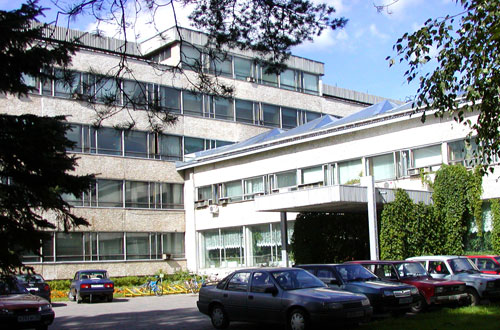
Osipyan Institute of Solid State Physics RAS (ISSP RAS) was formed by the USSR Academy of Sciences on February 15, 1963, with a view to realize an efficient combination and interaction between fundamental research in condensed matter physics and materials science. The decisive contribution regarding the objectives and principles of organization of ISSP was made by the prominent physical metallurgist Academician Georgii V.Kurdyumov, Academician Yury A. Osipyan and Corresponding Member of the USSR Ac. Sci. Cheslav V.Kopetsky.
The founders of the institute guessed the challenging potentialities of our domain of science combining the high activity standards, demand for novel results and those already obtained. Further advancement verified the correctness of the foundation ideas. Nowadays ISSP is one of the largest academic physical institutes and a recognized scientific center where manifold research is being done over a wide range of scientific problems. ISSP is also an educational center with long-term experience: over 200 trainees have been qualified as physical researchers and remained working at the institute. 300 PhDs and 60 DPhils have been prepared. Two researchers became Full Members and three Corresponding Members of the Russian Academy of Sciences (RAS).
At ISSP fundamental research is done in two principal directions:
- experimental and theoretical aspects of solid state physics;
- physical metallurgy as a combination of interrelated sections of fundamental physics, physical chemistry, mechanics.
The fundamental and applied research is ensured by the modern experimental and technological basis including:
- cryogenic facilities with helium liquefaction plant;
- equipment for investigation of electronic and optical properties of materials at liquid helium (and lower) temperatures and in ultrahigh magnetic fields: EPR, NMR, luminescence, Raman scattering, transport measurements, etc. (about 200 operating plants);
- equipment for analysis of crystalline structures; up-to-date automatic diffractometers provided with low and high temperature adapters, electron scanning, transmission electron tunneling microscopes, Auger-electron microscopy;
- special high pressure equipment (up to 500 kbar) for studies of transformations and for synthesis of novel hydrides of intermetallic compounds;
- ultrahigh magnetic field and extra-low temperature equipment for experiments with macroquantum objects;
- diverse crystals of semiconductor, dielectric, refractory metals, high-temperature superconductor single crystals are grown, special experience has been gained of synthesizing large crystals of fullerene, a novel form of carbon, techniques for chemical analysis, purification and synthesis are available;
- different techniques of material treatment have been developed: rolling, pressing, drawing deformation, annealing in a protective atmosphere of molybdenum, niobium, tungsten;
- studies of composite and nanocrystalline materials, including fabrication of alloys, mechanical tests at preset temperatures.
Our experience shows that the advanced and constantly renovated experimental basis is efficient for solving the problems of rapidly developed materials science and the problems of its high-tech applications.
The Institute includes: |
|
| Laboratories | 22 |
| Fabrication teams | 8 |
| Scientists | 250 |
| including | |
| PhDs | 121 |
| DPhils | 48 |
| members of Ac Sci | 8 |
| Postgraduates & undergraduates | 42 |
ISSP RAS is situated in Chernogolovka, one of the leading scientific centers of Russia, in the picturesque wooden Moscow area. Now there are 9 well-known scientific institutions of the RAS with a total number of scientists nearly 1000. Students from the Moscow Institute of Physics and Technology, the physical branch of the Moscow State University, and other institutions of higher education are studying and working as trainees.
Main Directions of Scientific Research of Osipyan Institute of Solid State Physics RAS (ISSP RAS)
- condensed matter physics and physical metallurgy;
- electrical, magnetic, electromagnetic, optical and mechanical properties of crystalline and amorphous materials and their based nano- and mesostructures;
- spectroscopy of solids and solid state structures;
- condensed matter structure, physics of defects, crystal growth;
- transport phenomena in crystalline and amorphous materials and structure;
- phase equilibrium states, phase transitions;
- low-dimensional structures, nano- and mesostructures and systems, atom and molecular structures;
- novel materials and structures;
- quantum macrosystems and quantum methods of telecommunication;
- new experimental methods of research and diagnostics of solids and solid state nano- and mesostructures;
- novel techniques of fabrication of solid state materials and structures.




